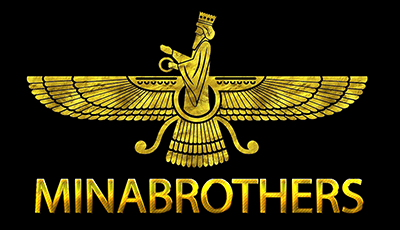IELTS Reading Placement Mock Test Computer Based
Quiz Summary
0 of 22 questions completed
Questions:
Information
You have already completed the quiz before. Hence you can not start it again.
Quiz is loading…
You must sign in or sign up to start the quiz.
You must first complete the following:
Results
Results
0 of 22 questions answered correctly
Your time:
Time has elapsed
You have reached 0 of 0 point(s), (0)
Earned Point(s): 0 of 0, (0)
0 Essay(s) Pending (Possible Point(s): 0)
Categories
- Not categorized 0%
- 1
- 2
- 3
- 4
- 5
- 6
- 7
- 8
- 9
- 10
- 11
- 12
- 13
- 14
- 15
- 16
- 17
- 18
- 19
- 20
- 21
- 22
- Current
- Review
- Answered
- Correct
- Incorrect
-
Question 1 of 22
1. Question
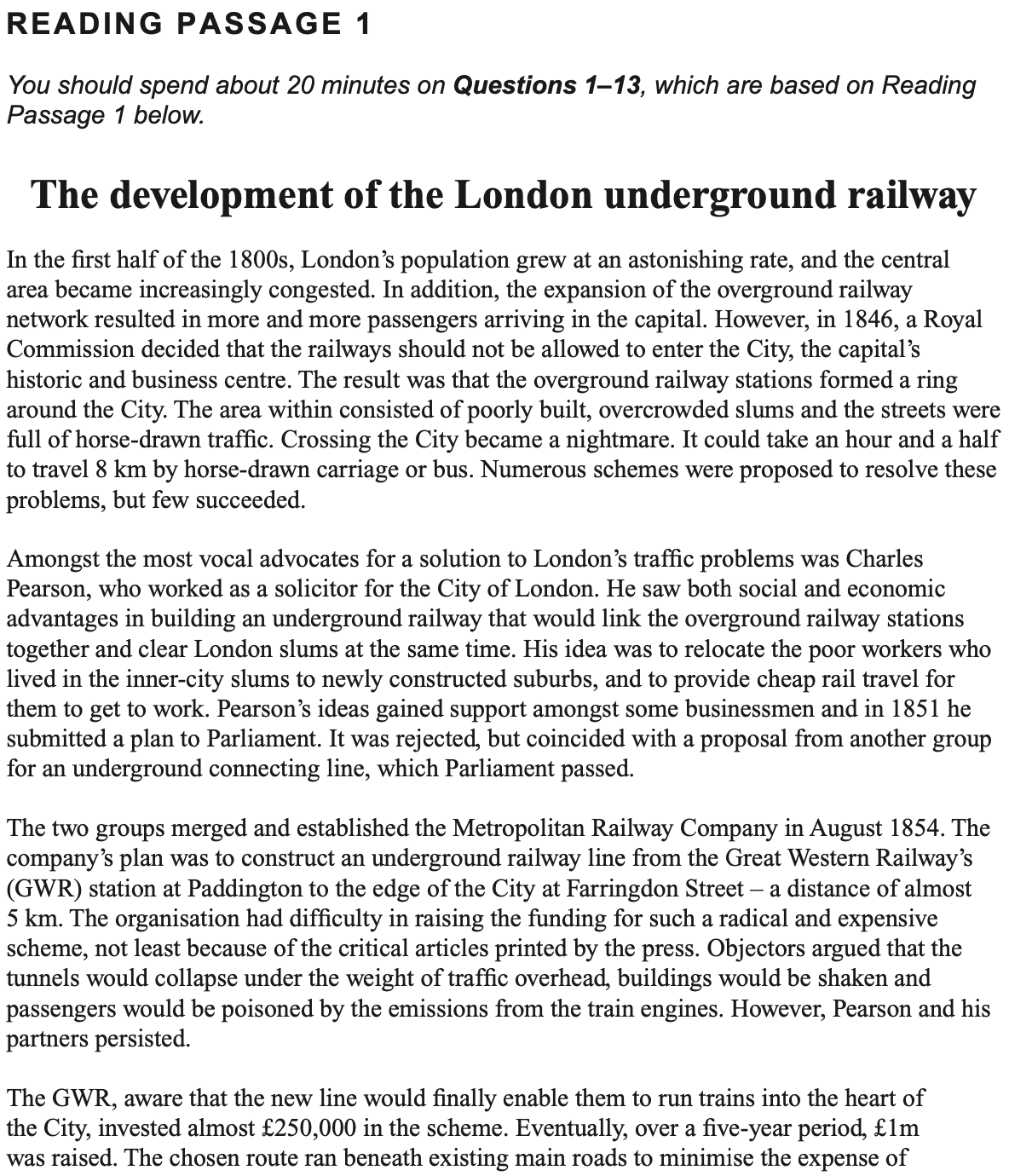
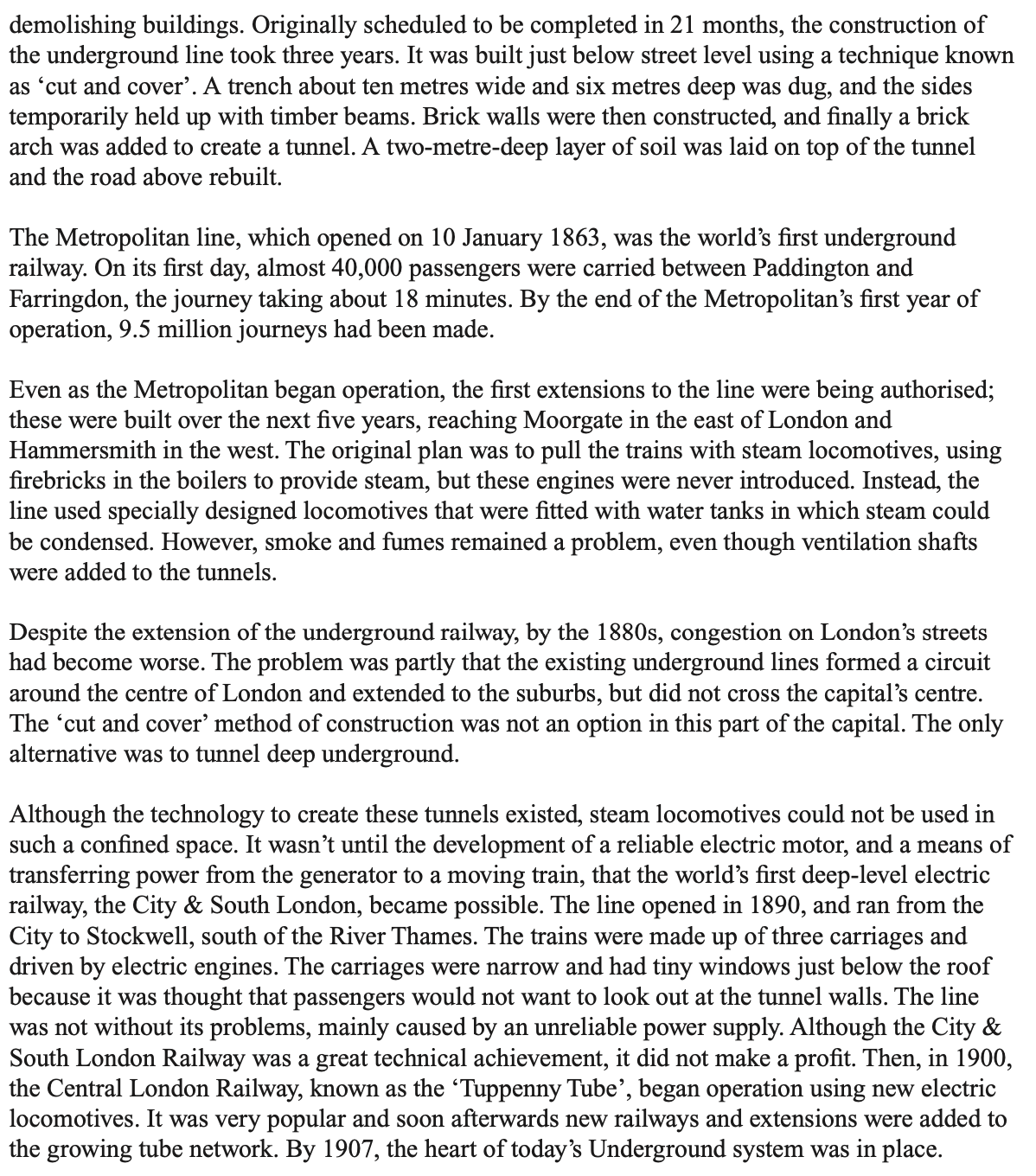
-
Questions 1–6
Complete the notes below.
Choose ONE WORD ONLY from the passage for each answer.The London underground railway
The problem
– The 1( )of London increased rapidly between 1800 and 1850
– The streets were full of horse-drawn vehicles
The proposed solution
– Charles Pearson, a solicitor, suggested building an underground railway
– Building the railway would make it possible to move people to better housing in
the 2( )
– A number of 3( )agreed with Pearson’s idea
– The company initially had problems getting the 4( )needed for the project
– Negative articles about the project appeared in the 5( )
The construction
– The chosen route did not require many buildings to be pulled down
– The ‘cut and cover’ method was used to construct the tunnels
– With the completion of the brick arch, the tunnel was covered with 6( )
CorrectIncorrect -
-
Question 2 of 22
2. Question
Questions 7-13
Do the following statements agree with the information given in Reading Passage 1?
write
TRUE if the statement agrees with the information
FALSE if the statement contradicts the information
NOT GIVEN if there is no information on this7- Other countries had built underground railways before the Metropolitan line opened.
CorrectIncorrect -
Question 3 of 22
3. Question
8- More people than predicted travelled on the Metropolitan line on the first
day.CorrectIncorrect -
Question 4 of 22
4. Question
9- The use of ventilation shafts failed to prevent pollution in the tunnels.
CorrectIncorrect -
Question 5 of 22
5. Question
10- A different approach from the ‘cut and cover’ technique was required in London’s
central area.CorrectIncorrect -
Question 6 of 22
6. Question
11- The windows on City & South London trains were at eve level.
CorrectIncorrect -
Question 7 of 22
7. Question
12- The City & South London Railway was a financial success.
CorrectIncorrect -
Question 8 of 22
8. Question
13- Trains on the ‘Tuppenny Tube’ nearly always ran on time.
CorrectIncorrect -
Question 9 of 22
9. Question
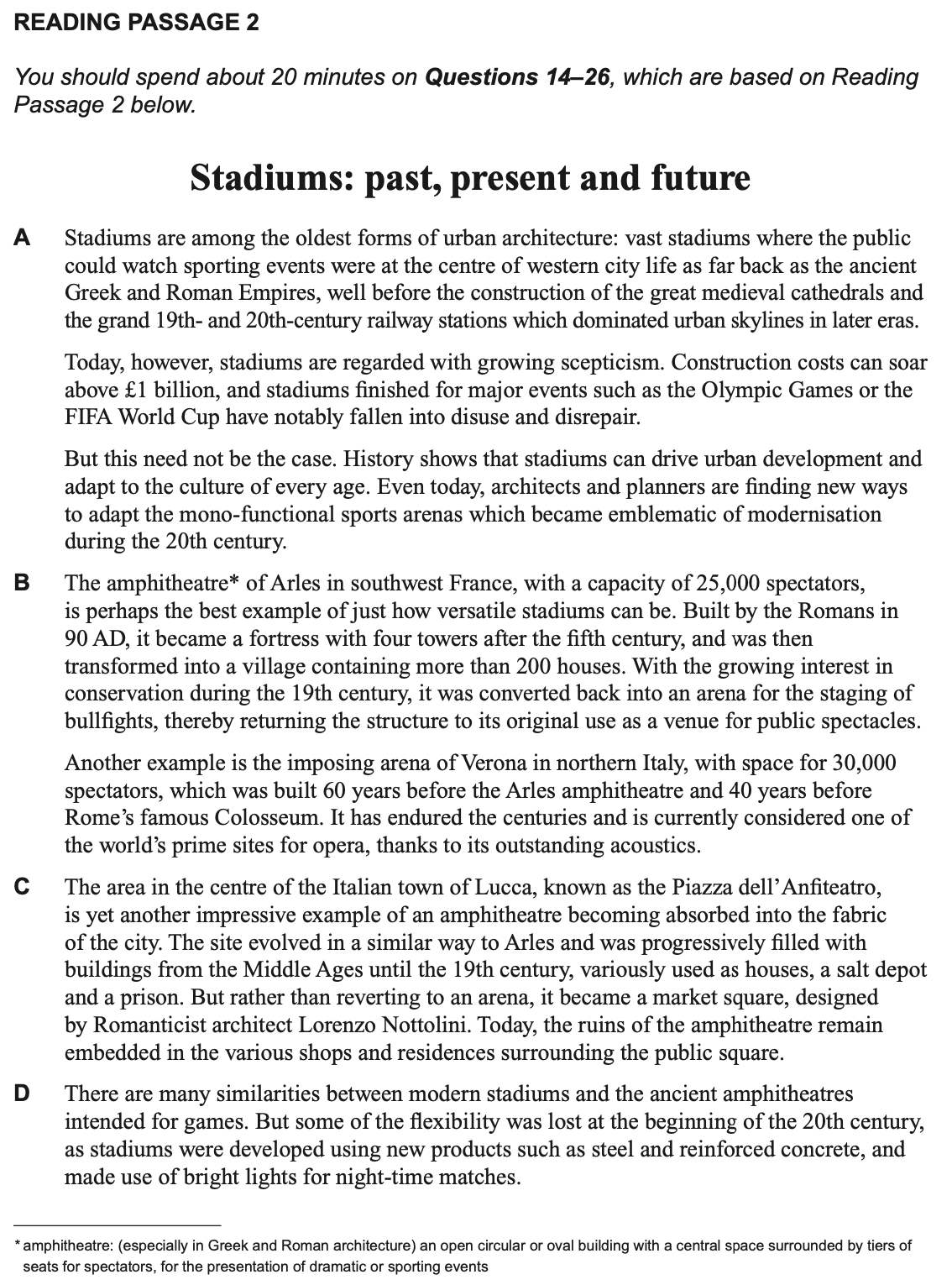

Questions 14–17
Reading Passage 2 has seven sections, A–G.
Which section contains the following information?
Write the correct letter, A–G, in boxes in front of statements 14–17.NB You may use any letter more than once.
-
-
a mention of negative attitudes towards stadium building projects( )
-
figures demonstrating the environmental benefits of a certain stadium( )
-
examples of the wide range of facilities available at some new stadiums( )
-
reference to the disadvantages of the stadiums built during a certain era( )
-
CorrectIncorrect -
-
Question 10 of 22
10. Question
Questions 18–22
Complete the summary below.
Choose ONE WORD ONLY from the passage for each answer.Write your answers in boxes 18–22.
-
Roman amphitheatres
The Roman stadiums of Europe have proved very versatile. The amphitheatre of Arles, for example, was converted first into a 18( ), then into a residential area and finally into an arena where spectators could watch 19( ). Meanwhile, the arena in Verona, one of the oldest Roman amphitheatres, is famous today as a venue where 20( )is performed. The site of Lucca’s amphitheatre has also been used for many purposes over the centuries, including the storage of 21( ). It is now a market square with 22( )and homes incorporated into the remains of the Roman amphitheatre.
CorrectIncorrect -
-
Question 11 of 22
11. Question
Questions 23 and 24
Choose TWO letters, A–E.
When comparing twentieth-century stadiums to ancient amphitheatres in Section D,
which TWO negative features does the writer mention?
CorrectIncorrect -
Question 12 of 22
12. Question
Questions 25 and 26
Choose TWO letters, A–E.
Which TWO advantages of modern stadium design does the writer mention?
CorrectIncorrect -
Question 13 of 22
13. Question
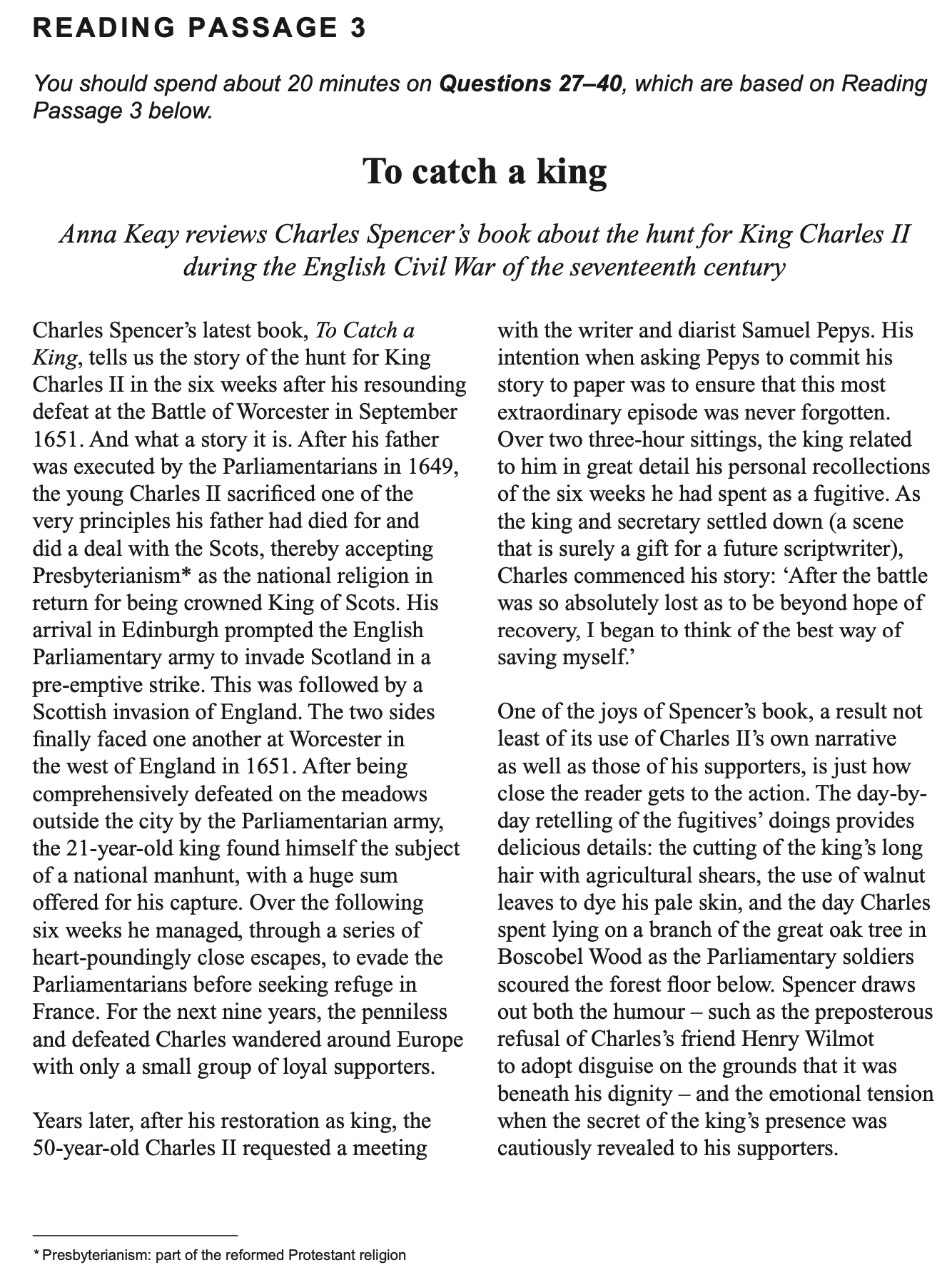

Questions 27–31
Complete the summary using the list of phrases. Write the letters A–J in the spaces below.

-
The story behind the hunt for Charles II
Charles II’s father was executed by the Parliamentarian forces in 1649. Charles II then formed a 27 ( ) with the Scots, and in order to become King of Scots, he abandoned an important 28 ( ) that was held by his father and had contributed to his father’s death. The opposing sides then met outside Worcester in 1651. The battle led to a 29 ( ) for the Parliamentarians and Charles had to flee for his life. A 30 ( ) was offered for Charles’s capture, but after six weeks spent in hiding, he eventually managed to reach the 31 ( ) of continental Europe.
CorrectIncorrect -
-
Question 14 of 22
14. Question
Questions 32–35
Do the following statements agree with the claims of the writer in Reading Passage 3?
Choose:
YES if the statement agrees with the claims of the writer
NO if the statement contradicts the claims of the writer
NOT GIVEN if it is impossible to say what the writer thinks about this-
Charles chose Pepys for the task because he considered him to be trustworthy.
CorrectIncorrect -
-
Question 15 of 22
15. Question
33 Charles’s personal recollection of the escape lacked sufficient detail.
CorrectIncorrect -
Question 16 of 22
16. Question
34 Charles indicated to Pepys that he had planned his escape before the battle.
CorrectIncorrect -
Question 17 of 22
17. Question
35 The inclusion of Charles’s account is a positive aspect of the book.
CorrectIncorrect -
Question 18 of 22
18. Question
Questions 36–40
Choose the correct letter, A, B, C, or D.-
What is the reviewer’s main purpose in the first paragraph?
CorrectIncorrect -
-
Question 19 of 22
19. Question
37. Why does the reviewer include examples of the fugitives’ behaviour in the third paragraph?
CorrectIncorrect -
Question 20 of 22
20. Question
38. What point does the reviewer make about Charles II in the fourth paragraph?
CorrectIncorrect -
Question 21 of 22
21. Question
39. What does the reviewer say about Charles Spencer in the fifth paragraph?
CorrectIncorrect -
Question 22 of 22
22. Question
40. When the reviewer says the book ‘doesn’t quite hit the mark’, she is making the point that
CorrectIncorrect
